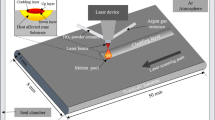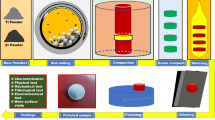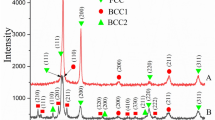Abstract
Titanium (Ti) metal was soaked in HCl solution after NaOH treatment and then subjected to heat treatments at different temperatures. Their apatite-forming abilities in a simulated body fluid (SBF) were discussed in terms of their surface structures and properties. The nanometer scale roughness formed on Ti metal after NaOH treatment remained after the HCl treatment and a subsequent heat treatment below 700°C. Hydrogen titanate was formed on Ti metal from an HCl treatment after NaOH treatment, and this was converted into titanium oxide of anatase and rutile phases by a subsequent heat treatment above 500°C. The scratch resistance of the surface layer increased with the formation of the titanium oxide after a heat treatment up to 700°C, and then decreased with increasing temperature. The Ti metal with a titanium oxide layer formed on its surface showed a high apatite-forming ability in SBF when the heat treatment temperature was in the range 500–700°C. The high apatite-forming ability was attributed to the positive surface charge in an SBF. These positive surface charges were ascribed to the presence of chloride ions, which were adsorbed on the surfaces and dissociated in the SBF to give an acid environment.








Similar content being viewed by others
References
Textor M, Sittig C, Frauchiger V, Tosatti S, Brunette DM. Properties and biological significance of natural oxide films on titanium and its alloys. In: Brunette DM, Tengvall P, Textor M, Thomsen P, editors. Titanium in medicine. Germany: Springer; 2001. p. 171–230.
Hacking SA, Tanzer M, Harvey EJ, Krygier JJ, Bobyn JD. Relative contributions of chemistry and topography to the osseointegration of hydroxyapatite coatings. Clin Orthop Relat Res. 2002;405:24–38.
Kokubo T, Miyaji F, Kim HM, Nakamura T. Spontaneous formation of bonelike apatite layer on chemically treated titanium metals. J Am Ceram Soc. 1996;79:1127–9.
Kim HM, Miyaji F, Kokubo T, Nakamura T. Preparation of bioactive Ti and its alloy via simple chemical surface treatment. J Biomed Mater Res. 1996;32:409–17.
Yan WQ, Nakamura T, Kobayashi M, Kim HM, Miyaji F, Kokubo T. Bonding of chemically treated titanium implants to bone. J Biomed Mater Res. 1997;37:267–75.
Nishiguchi S, Fujibayashi S, Kim HM, Kokubo T, Nakamura T. Biology of alkali- and heat-treated titanium implants. J Biomed Mater Res. 2003;67A:26–35.
Kawanabe K, Ise K, Goto K, Akiyama H, Nakamura T, Kaneuji A, Sugimori T, Matsumoto T. A new cementless total hip arthoplasty with bioactive titanium porous-coating by alkaline and heat treatment: average 4.8-year results. J Biomed Mater Res. 2009;90B:476–81.
Pattanayak DK, Kawai T, Matsushita T, Takadama H, Kokubo T, Nakamura T. Effect of HCl concentrations on apatite-forming ability of NaOH-HCl- and heat-treated titanium metal. J Mater Sci Mater Med. 2009;20:2401–11.
Takemoto M, Fujibayashi S, Neo M, Suzuki J, Kokubo T, Nakamura T. Mechanical properties and osteoconductivity of porous bioactive titanium. Biomaterials. 2005;26:6014–23.
Takemoto M, Fujibayashi S, Neo M, Suzuki J, Matsushita T, Kokubo T, Nakamura T. Osteoinductive porous titanium implants: effect of sodium removal by dilute HCl treatment. Biomaterials. 2006;27:2682–91.
Takemoto M, Fujibayashi S, Neo M, So K, Akiyama N, Matsushita T, Kokubo T, Nakamura T. A porous bioactive titanium implant for spinal interbody fusion: an experimental study using a canine model. J Neurosurg Spine. 2007;7:435–43.
Kokubo T, Takadama H. How useful is SBF in predicting in vivo bone bioactivity? Biomaterials. 2006;27:2907–15.
Sun X, Li Y. Synthesis and characterization of ion-exchangeable titanate nanotubes. Chem Eur J. 2003;9:2229–38.
Tsai CC, Teng H. Structural features of nanotubes synthesized from NaOH treatment on TiO2 with different post-treatments. Chem Mater. 2006;18:367–73.
Kokubo T, Pattanayak DK, Yamaguchi S, Takadama H, Matsushita T, Kawai T, Takemoto M, Fujibayashi S, Nakamura T. Positively charged bioactive titanium metal prepared by simple chemical and heat treatments. J R Soc Interface. 2010;7:S503–13.
Bruijn JDD, Shankar K, Yuan H, Habibovic P. Osteoinduction and its evaluation. In: Kokubo T, editor. Bioceramics and their clinical applications. Cambridge: Woodhead publishing Ltd; 2008. p. 199–219.
Author information
Authors and Affiliations
Corresponding author
Rights and permissions
About this article
Cite this article
Pattanayak, D.K., Yamaguchi, S., Matsushita, T. et al. Effect of heat treatments on apatite-forming ability of NaOH- and HCl-treated titanium metal. J Mater Sci: Mater Med 22, 273–278 (2011). https://doi.org/10.1007/s10856-010-4218-y
Received:
Accepted:
Published:
Issue Date:
DOI: https://doi.org/10.1007/s10856-010-4218-y




